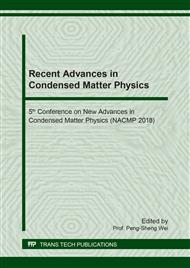[1]
J. G. Bednorz and K. A. Müller, Possible High Tc Superconductivity in the Ba-La-Cu-O System, Z. Phys. B: Condens. Matter 64 (1986) 189-193.
Google Scholar
[2]
See, e.g., the review, M. A. Kastner, R. J. Birgeneau, G. Shirane, Y. Endoh, Magnetic, transport, and optical properties of monolayer copper oxides, Rev. Mod. Phys. 70 (1998) 897-928.
DOI: 10.1103/revmodphys.70.897
Google Scholar
[3]
See, e.g., the review, M. Fujita, H. Hiraka, M. Matsuda, M. Matsuura, J. M. Tranquada, S. Wakimoto, G. Xu, K. Yamada, Progress in Neutron Scattering Studies of Spin Excitations in High-Tc Cuprates, J. Phys. Soc. Jpn. 81 (2012) 011007.
DOI: 10.1143/jpsj.81.011007
Google Scholar
[4]
See, e.g., the review, M. Eschrig, The effect of collective spin-1 excitations on electronic spectra in high-Tc superconductors, Adv. Phys. 55 (2006) 47.
Google Scholar
[5]
S. Wakimoto, K. Yamada, J. M. Tranquada, C. D. Frost, R. J. Birgeneau, H. Zhang, Disappearance of Antiferromagnetic Spin Excitations in Overdoped La2−xSrxCuO4, Phys. Rev. Lett. 98 (2007) 247003.
DOI: 10.1016/j.physc.2007.03.306
Google Scholar
[6]
Ph. Bourges, B. Keimer, S. Pailhès, L. P. Regnault, Y. Sidis, C. Ulrich, The resonant magnetic mode: A common feature of high-Tc superconductors, Physica C 424 (2005) 45-49.
DOI: 10.1016/j.physc.2003.11.086
Google Scholar
[7]
H. A. Mook, M. Yethiraj, G. Aeppli, T. E. Mason, T. Armstrong, Polarized neutron determination of the magnetic excitations in YBa2Cu3O7, Phys. Rev. Lett. 70 (1993) 3490-3493.
Google Scholar
[8]
P. Dai, H. A. Mook, S. M. Hayden, G. Aeppli, T. G. Perring, R. D. Hunt, F. Doǧan, The Magnetic Excitation Spectrum and Thermodynamics of High-Tc Superconductors, Science 284 (1999) 1344-1347.
DOI: 10.1126/science.284.5418.1344
Google Scholar
[9]
H. F. Fong, P. Bourges, Y. Sidis, L. P. Regnault, A. Ivanov, G. D. Guk, N. Koshizuka, B. Keimer, Neutron scattering from magnetic excitations in Bi2Sr2CaCu2O8+δ, Nature 398 (1999) 588-591.
DOI: 10.1038/19255
Google Scholar
[10]
F. Yuan, S. Feng, Z.-B. Su, L. Yu, Doping and temperature dependence of incommensurate antiferromagnetism in underdoped lanthanum cuprates, Phys. Rev. B 64 (2001).
DOI: 10.1103/physrevb.64.224505
Google Scholar
[11]
S. Feng, J. Qin, T. Ma, A gauge invariant dressed holon and spinon description of the normal state of underdoped cuprates, J. Phys.: Condens. Matter 16 (2004) 343-359.
DOI: 10.1088/0953-8984/16/3/014
Google Scholar
[12]
S. Feng, Kinetic energy driven superconductivity in doped cuprates, Phys. Rev. B 68 (2003) 184501; S. Feng, T. Ma, H. Guo, Magnetic nature of superconductivity in doped cuprates, Physica C 436 (2006) 14-24.
DOI: 10.1016/j.physc.2006.01.001
Google Scholar
[13]
See, e.g., the review, S. Feng, Y. Lan, H. Zhao, L. Kuang, L. Qin, X. Ma, Kinetic-energy-driven superconductivity in cuprate superconductors, Int. J. Mod. Phys. B 29 (2015) 1530009.
DOI: 10.1142/s0217979215300091
Google Scholar
[14]
L. Kuang, Y. Lan, S. Feng, Dynamical spin response in cuprate superconductors from low-energy to high-energy, J. Magn. Magn. Mater. 374 (2015) 624-633.
DOI: 10.1016/j.jmmm.2014.09.018
Google Scholar
[15]
P. W. Anderson, The Resonating Valence Bond State in La2CuO4 and Superconductivity, Science 235 (1987) 1196-1198.
Google Scholar
[16]
S. Feng, Z. B. Su, L. Yu, Fermion-spin transformation to implement the charge-spin separation, Phys. Rev. B 49 (1994) 2368-2384.
DOI: 10.1103/physrevb.49.2368
Google Scholar
[17]
V. M. Svistunov, V. Yu. Tarenkov, A. I. D'yachenko, E. Hatta, Temperature Dependence of the Energy Gap in Bi2223 Metal Oxide Superconductor, JETP Lett. 71 (2000) 289-292.
DOI: 10.1134/1.568336
Google Scholar
[18]
S. D. Wilson, P. Dai, S. Li, S. Chi, H. J. Kang, J. W. Lynn, Resonance in the electron-doped high-transition temperature superconductor Pr0.88LaCe0.12CuO4−δ, Nature 442 (2006) 59-62.
DOI: 10.1038/nature04857
Google Scholar
[19]
A. M. Panich, S. D.Goren, L. F. Ben-Yakar, M. Eder, G. Gritzner, Thallium and lead NMR studies of (Tl0.5Pb0.5)(Ba0.2Sr0.8)2Ca2Cu3Oy superconductors, Physica C 356 (2001) 129-140.
DOI: 10.1016/s0921-4534(01)00147-2
Google Scholar
[20]
P. Monthoux and D. Pines, Spin-fluctuation-induced superconductivity and normal-state properties of YBa2Cu3O7, Phys. Rev. B 49 (1994) 4261-4278.
Google Scholar
[21]
T. Moriya, K. Ueda, Spin Fluctuation Spectra and High Temperature Superconductivity, J. Phys. Soc. Jpn. 63 (1994) 1871-1880.
DOI: 10.1143/jpsj.63.1871
Google Scholar


